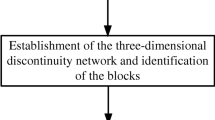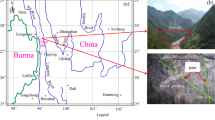Abstract
This paper presents a technique for estimating the geometrical representative elementary volume (REV) of a fractured rock mass based on fracture connectivity. A three-dimensional fracture network model, of dimensions 78 m × 50 m × 50 m, was generated and validated for a granite rock mass using joint data collected from an exploration tunnel at the Songta dam site in southwest China. Two hundred and forty cubic specimens with edge lengths ranging from 1 to 20 m were sampled from the model, and connectivity parameters of each specimen, including the number of intersections per unit volume (C 1) and the intersection length per unit volume (L 1), were calculated. The REV was determined using the connectivity parameters and a series of statistical tests. The results demonstrate that both the C 1- and L 1-based REVs are equal to 11 m × 11 m × 11 m. In this work, the volumetric fracture intensity (P32) was also used to calculate the REV for comparison. The REV obtained by P32 is 9 m × 9 m × 9 m, which is smaller than that calculated by C 1 and L 1. Finally, the geometrical REV for the rock mass by integrating C 1, L 1, and P32 is 11 m × 11 m × 11 m.








Similar content being viewed by others
References
Baghbanan A, Jing L (2007) Hydraulic properties of fractured rock masses with correlated fracture length and aperture. Int J Rock Mech Min Sci 44(5):704–719
Baghbanan A, Jing L (2008) Stress effects on permeability in a fractured rock mass with correlated fracture length and aperture. Int J Rock Mech Min Sci 45:1320–1334
Chen JP (2001) 3-D network numerical modeling technique for random discontinuities of rock mass. Chin J Geotech Eng 23:397–402
Dershowitz WS, Einstein HH (1988) Characterizing rock joint geometry with joint system models. Rock Mech Rock Eng 21:21–51
de Dreuzy JR, Davy P, Bour O (2001a) Hydraulic properties of two-dimensional random fracture networks following a power law length distribution 1. Effective connectivity. Water Resour Res 37(8):2065–2078
de Dreuzy JR, Davy P, Bour O (2001b) Hydraulic properties of two-dimensional random fracture networks following a power law length distribution 2. Permeability of networks based on lognormal distribution of apertures. Water Resour Res 37(8):2079–2095
Einstein HH, Locsin JLZ (2012) Modeling rock fracture intersections and application to the Boston area. J Geotech Geoenviron Eng 138(11):1415–1421
Esmaieli K, Hadjigeorgiou J, Grenon M (2010) Estimating geometrical and mechanical REV based on synthetic rock mass models at Brunswick mine. Int J Rock Mech Min Sci 47:915–926
Han X, Chen JP, Wang Q, Li Y, Zhang W, Yu T (2016) A 3D fracture network model for the undisturbed rock mass at the Songta dam site based on small samples. Rock Mech Rock Eng 49:611–619
Ivanova VM, Sousa R, Murrihy B, Einstein HH (2014) Mathematical algorithm development and parametric studies with the GEOFRAC three-dimensional stochastic model of natural rock fracture systems. Comput Geosci 67:100–109
Khani A, Baghbanan A, Hashemolhosseini H (2013) Numerical investigation of the effect of fracture intensity on deformability and REV of fractured rock masses. Int J Rock Mech Min Sci 63:104–112
Kulatilake PHSW, Panda BB (2000) Effect of block size and joint geometry on jointed rock hydraulics and REV. J Eng Mech 126:850–858
Kulatilake PHSW, Wu TH (1984) Estimation of mean trace length of discontinuities. Rock Mech Rock Eng 17:215–232
Kulatilake PHSW, Wu TH (1986) Relation between discontinuity size and trace length. In: Hartman HL (ed) Proceedings of the 27th US symposium on rock mechanics. University of Alabama, Tuscaloosa, pp 130–133
Li JH, Zhang LM (2010) Geometric parameters and REV of a crack network in soil. Comput Geotech 37:466–475
Li JH, Zhang LM (2011) Connectivity of a network of random discontinuities. Comput Geotech 38:217–226
Li Y, Wang Q, Chen JP, Han L, Song S (2014) Identification of structural domain boundaries at the Songta dam site based on nonparametric tests. Int J Rock Mech Min Sci 70:177–184
Li Y, Wang Q, Chen JP, Xu L, Song S (2015) K-means algorithm based on particle swarm optimization for the identification of rock discontinuity sets. Rock Mech Rock Eng 48:375–385
Lu B, Ge XR, Zhu DL, Chen JP (2005) Fractal study on the representative elementary volume of jointed rock masses. Chin J Rock Mech Eng 24:1355–1361
Manda AK, Mabee SB (2010) Comparison of three fracture sampling methods for layered rocks. Int J Rock Mech Min Sci 47:218–226
Mann HB, Whitney DR (1947) On a test of whether one of two random variables is stochastically larger than the other. Ann Math Stat 18:50–60
Martínez-Murcia FJ, Górriz JM, Ramírez J, Puntonet CG, Salas-González D (2012) Computer aided diagnosis tool for Alzheimer’s disease based on Mann–Whitney–Wilcoxon U-test. Expert Syst Appl 39:9676–9685
Oda M (1982) Fabric tensor for discontinuous geological materials. Soil Found 22:96–108
Pariseau WG, Puri S, Schmelter SC (2008) A new model for effects of impersistent joint sets on rock slope stability. Int J Rock Mech Min Sci 45:122–131
Priest SD (2004) Determination of discontinuity size distributions from scanline data. Rock Mech Rock Eng 37:347–368
Tóth TM, Vass I (2011) Relationship between the geometric parameters of rock fractures, the size of percolation clusters and REV. Math Geosci 43:75–97
Yue S, Wang CY (2002) The influence of serial correlation on the Mann–Whitney test for detecting a shift in median. Adv Water Resour 25:325–333
Zhang GK, Xu WY (2008) Analysis of joint network simulation method and REV scale. Rock Soil Mech 29:1675–1680
Zhang W, Chen JP, Liu C, Huang R, Li M, Zhang Y (2012) Determination of geometrical and structural representative volume elements at the Baihetan dam site. Rock Mech Rock Eng 45:409–419
Zhang W, Chen JP, Yuan XQ, Xu PH, Zhang C (2013) Analysis of RVE size based on three-dimensional fracture numerical network modelling and stochastic mathematics. Q J Eng Geol Hydrogeol 46:31–40
Zhang Q, Wang Q, Chen JP, Li Y, Ruan YK (2016) Estimation of mean trace length by setting scanlines in rectangular sampling window. Int J Rock Mech Min Sci 84:74–79
Acknowledgments
This work was financially supported by the Strategic Priority Research Program of the Chinese Academy of Sciences (no. XDB10030100), the National Natural Science Foundation of China (NSFC) (nos. 41602327 and 41372324), and a China Postdoctoral Science Foundation funded project (no. 2015 M580135).
Author information
Authors and Affiliations
Corresponding author
Rights and permissions
About this article
Cite this article
Li, Y., Chen, J. & Shang, Y. Determination of the geometrical REV based on fracture connectivity: a case study of an underground excavation at the Songta dam site, China. Bull Eng Geol Environ 77, 1599–1606 (2018). https://doi.org/10.1007/s10064-017-1063-y
Received:
Accepted:
Published:
Issue Date:
DOI: https://doi.org/10.1007/s10064-017-1063-y




